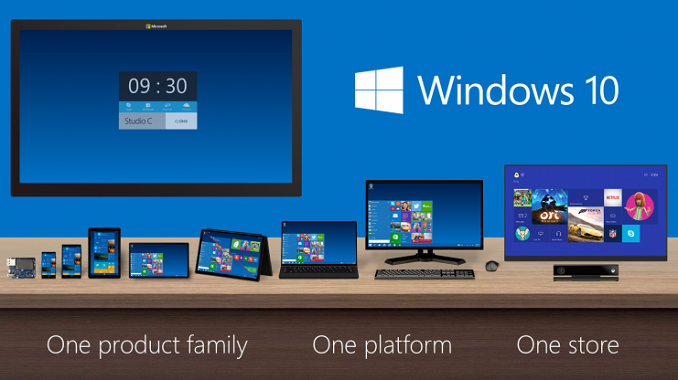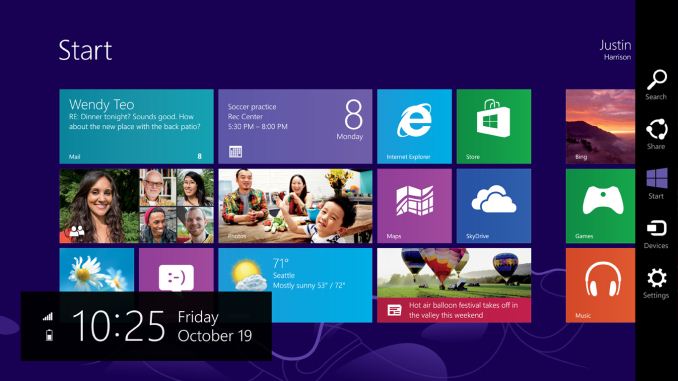Windows 10 Technical Preview First Impressions: The Return Of The Desktop
by Brett Howse on November 13, 2014 8:00 AM EST- Posted in
- Software
- Microsoft
- Windows 10

I’ve said this before, and I will reiterate it now. Windows 8, in general, is not perceived in a positive light. Not necessarily because of the lack of features, or even due to the touch first interface, but because from the start people did not buy into the paradigm. We can argue over why that was, and the specifics are likely different for every individual. But a big part of that was that Windows, which has had a familiar interface since Windows 95, had changed dramatically in look, feel, and general use. The traditional mouse and keyboard PC and notebook is a big part of the Windows user base, and especially at the beginning, Windows 8 did not cater to that crowd. While there were certainly improvements to the desktop, it was not enough to overcome the negative feelings of many users in regards to being productive on their PC. I say this as a fan of Windows 8.1, and I say this despite the positive review from this site. Windows 8 was an OS that worked, but had a steep learning curve that many people did not want to bother learning.
One of the biggest issues facing Windows 8 was just how much people liked Windows 7. Windows 7 was seen as the savior to Vista, and fixed many of its issues. But a lot of the initial problems with Vista were due to a major change in the driver model as well as the security model, which caused a lot of compatibility issues with older programs which expected administrator rights, as well as many hardware devices needed driver updates. With Windows 7, all of those changes were in the rear view mirror, allowing 7 to be a tweak of the overall UI and functionality rather than a rebuild of the OS from the ground up. With Windows 8, the move to touch first caused another dramatic upheaval. This time, rather than incompatible programs and hardware, we got a new Start Screen, a new runtime in WinRT, and a new app model with the Windows Store. For reasons that will never be made clear, the familiar start button was even removed, with the designers relying on hidden functions such as the hot corners to navigate around the OS with a mouse and keyboard. Luckily this change was reversed for Windows 8.1, with the start button returning, even if it still opened the Start Screen. With the Windows 8.1 Update, the system was made much more usable for a mouse and keyboard with the return of the menu bar to close apps, rather than dragging them down off the screen, and several other changes as well which brought the balance back somewhat to cover both touch interfaces as well as the mouse and keyboard.
 Windows 8 at launch in October 2012
Windows 8 at launch in October 2012
With Windows 8, Microsoft tried out an operating system which would work with a single interface across a breadth of hardware, from small form factor tablets, up to 30” monitor desktops. While they certainly succeeded in creating an interface that worked across all of those platforms, it was not ideally suited to any of them. With the tablet mode, the new Start Screen worked very well, and the charms menu and app switcher were fairly easy to use. But many of the settings and programs would be on the desktop, where touch only worked sparingly. Some desktop applications, such as Office, were created with a touch mode to increase the size of the onscreen elements, but overall the experience was subpar. Similarly, on the desktop, the touch interfaces were not ideal, and the hot corners certainly had issues especially on multi-monitor systems.
Windows 10 Technical Preview at launch
But now we come to Windows 10. Windows 10 is ditching the “One Interface to Rule them All” mentality, and moving to a more user friendly model of a single store across all platforms, and multiple interfaces to the same OS depending on the current usage model. We have not seen all of this in practice as of yet in the Technical Preview, but Microsoft has demonstrated their solution to this change in input mode with a feature they are calling Continuum.
The goal is that those that are on a keyboard and mouse based system will have the traditional start menu and desktop, with apps in windows, but if you are on a touch based device, or if you go on a 2-in-1 from keyboard to touch, the system will switch to the Windows 8 style start screen with full screen apps.
One of the keys to having this experience is an app model that allows a developer to target this different user interface paradigms. Microsoft’s solution to this is Universal Apps.











198 Comments
View All Comments
boe - Sunday, November 30, 2014 - link
Now if MS could only program all the stuff back into their servers that they expect you to type with powershell I'll be thrilled. When is the last time someone here went to a command prompt and typed dir or del or ren? GUI is what made computers popular with normal people you f'n suspender wearing, Linux wannabes!partofthepuzzle - Saturday, December 6, 2014 - link
Most of the slated changes for Windows 10 seem like significant improvements tome and I'm relatively optimistic about the possibilities of moving the 200+ PC users to it (after the initial bugs, etc. have been shaken out). My biggest reservation is forcing access to WinRT apps through the Windows Store. I realize there are options for side loading but in my shop ( development house) eliminating the ability for a user to freely install an app when they choose could be a deal breaker.Beyond my company specific needs, for the home users, I can also the Windows Store only availability of WinRT apps being a major turn off and something that could significantly reduce the interest in WinRT apps for the general public.
twtech - Thursday, December 11, 2014 - link
Windows 8 apologists usually end up talking about how it's "not that bad", and that it's ultimately functional after a long learning curve.Frankly, if Windows 7 didn't exist, most of us probably would be using Windows 8. However, Windows 7 does exist, and it's just as functional as Windows 8, but with a more desktop-user-friendly UI.
So why would a Windows 7 user want to switch to Windows 8? If what it boils down is that 8 is a bigger number than 7, that's not a compelling argument. If I'm "upgrading" it should be to a better product, not one that is "only a little bit worse after you get used to it."
JonnyDough - Friday, January 16, 2015 - link
"As an attempt to keep malware at bay, Windows 10 can only allow trusted applications to be run on it. That trust can come from Microsoft, or from OEMs and organizations. A company can sign apps themselves if they wish, choose apps signed by particular software vendors, apps from the Windows Store, or all of the above."Best feature by far. This could be a major kick in the pants for malware.
geekfool - Wednesday, July 1, 2015 - link
i tried beta and don like the Windows 10 Edge browser... it is is brokenthis was previously known by the codename Project Spartan.
With Edge you can’t save a web page as a web archive (which combines all the text, graphics and layout into a single MSHTML file). And you can’t pin sites to the Windows 10 taskbar, as you could with IE.
it dosnt even do justice to some html 5 coded sites
Thats my 2cents anyway
Jeff frm http://www.forgotcomputerpassword.com/